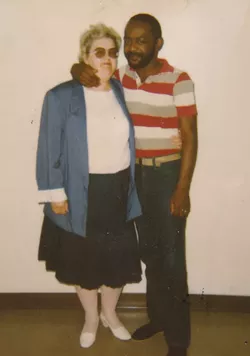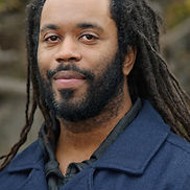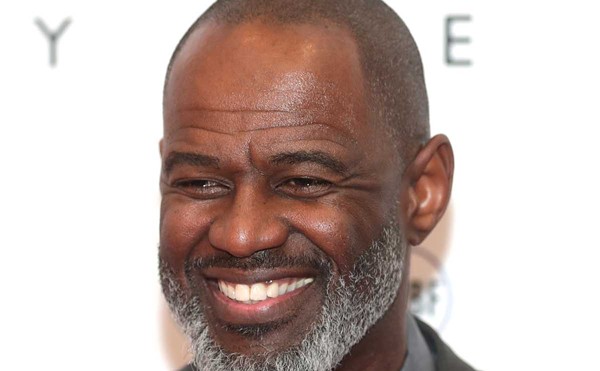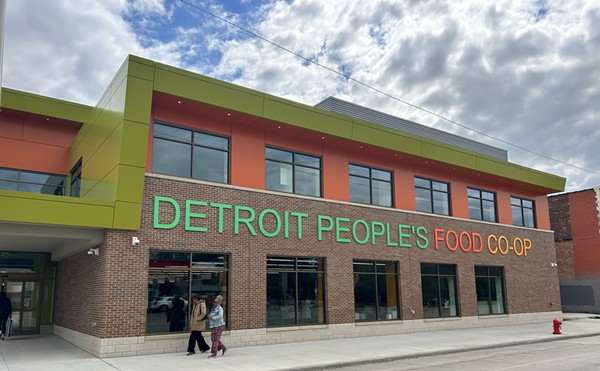Prison cells and paintbrushes represent constants and contrasts for Ray Gray.
Since a life-changing night almost 50 years ago, he has earned a dubious distinction as one of the longest-serving and most brilliantly talented inmates in Michigan, if not in the entire country.
"I was at home. I was a boxer, and I was contemplating turning professional," Gray says, remembering the evening of Feb. 6, 1973.
Ironically, the same gifted hands he often used to render soft, yet striking artistic images could be folded into the fists of a punishing pugilist. Now, near the date of a tragic 47th anniversary, a witness to the crime that thwarted the one-time Golden Gloves champ's career has provided information that could ultimately help him win the true fight of his life.
So multitalented was Gray that he was pondering enrollment in a local art school, as well as boxing as a pro featherweight. At 21, his future seemed filled with possibilities, but, little did he know, a brief encounter with an old associate just a short time earlier would send him on a detour that keeps winding decades later.
Two men had come to visit Gray at the Allendale Street home he shared with family members on Detroit's west side. He'd known one of the men, Tyrone Pugh, since he'd been a teenager.
"The other guy I didn't know, and he was inquiring about some drugs," Gray recalls, his gentle voice steady during several 15-minute phone calls from Muskegon Correctional Facility.
Pugh, Gray says, was AWOL from the Army. Like many other ex-soldiers, especially those who went to war in Southeast Asia during the mid-'60s, he returned to his hometown with a full-blown drug habit. Gray says he isn't sure why Pugh chose him to visit, other than their years-long acquaintance and Pugh's lack of contacts for scoring heroin since he'd been away in the military.
"I didn't want to be involved," says Gray. "I had a life, I had things going for me."
He knew people who sold drugs, having gone to school with them, but that was the extent of his association with illegal dealing, Gray says.
"I didn't have drugs to give him, nor was I interested," he adds.
But Barbara Hill, a woman he describes as "loosely a girlfriend," was visiting Gray at the time Pugh and the other man, Charlie Mathews, popped in. Hill offered to lead Pugh and Mathews to someone who could give them what they wanted.
"The next thing I know, I get a call from the police department that somebody had been robbed and killed," Gray says.
The caller was Hill. She was questioned by Detroit Police.
Two Fu Manchus
The level of affection between Hill and Gray wasn't entirely mutual. He was more taken with a young woman named Sandra Smith, whose portrait he'd drawn earlier in the day. Along with his punching skills and artistic gift, he was an unlicensed barber with a makeshift shop at home. Smith would later testify that Gray was styling her hair at 8:30 p.m., about the time a crime was being committed in a Euclid Street apartment.
Hill's phone call from the police station offered Gray her version of what happened after she left Allendale with Pugh and Mathews: Taking them to the spot on Euclid, she planned to help them score heroin from Reuben Bryant, a longtime friend she referred to as her "cousin"; Hill said she was completely caught off-guard when Mathews pulled out a pistol as the apartment door was opened for her. She knew that Bryant, a military vet and Chrysler employee, sold drugs at the address. At some point, he decided to fight back against his robbers, using a table to pin Pugh against the wall with it.
Mathews responded by pulling the trigger.
Accounts of the episode differ, including Mathews' own 1983 court testimony, his other contradictory statements, and a Dec. 1, 1980 affidavit in which he alleged Pugh was the actual shooter. What Mathews, Smith, and three other witnesses all corroborated at Gray's trial and motion for a new trial, which the court denied, is that Gray had nothing to do with the crime. Hill, initially suspected by police of setting up Bryant to become the victim, has also given contradicting statements. But Gray's supporters, including private investigator and former WXYZ Channel 7 news reporter Bill Proctor, are hopeful that an affidavit Hill signed in September 2019 will finally help set Gray free. The document provided by Hill, 65, is the first known evidence identifying Pugh and Mathews, both deceased, as Bryant's robbers.
Gray was arrested a little more than a week after receiving Hill's phone call from the police station. He was convicted May 11, 1973. Judge Justin Ravitz, who'd been called the nation's first "radical" lawyer elected to the bench after years of activism and Detroit Police reform efforts, sentenced Gray to life in prison with no parole. Two women at the apartment when the robbery occurred, including Bryant's girlfriend, testified that Gray resembled the shooter. Both Gray and Mathews wore what was then known as a "Fu Manchu" mustache, their most notable common trait. The style was inspired by the villain in a British novel series.
Gray knew Bryant, though they "weren't good buddies," he says. He certainly had no motive to kill him or thoughts of committing robbery, Gray maintains.
Convicted of murder, his most serious prior legal infraction had been clumsily pulling a friend's car into a gas station, a favor that earned him a ticket for driving without a license at age 19.
"To this day," Gray says, "I don't know how to drive a car."
When God is neutral
A man locked up for nearly five decades might have more reason than the average Detroiter to have missed out on driving lessons, but cars were never common at the Gray household. His father, Charles, a construction worker, rode a bike around their neighborhood, a spectacle that made Gray the object of ridicule by children at school: "I saw your mama riding on the handlebars!" they'd embellish.
Gray used his raw talent to defend his family's honor.
"I was pretty good at drawing, so I would draw their mama and daddy," he chuckles.
Apart from occasional ridicule, Charles was a source of inspiration to Gray, who inherited his father's love of boxing.
"He didn't drink or smoke," Gray says. "He wasn't a party guy."
Perhaps befitting a man who insists he's been wrongly convicted of murder, Gray repeats one lesson, in particular, that his father impressed on him: "He used to always tell me that one of the most important things you have is your word."
Both Charles and Jane Gray, Ray's mother, were artists, another family legacy that benefited him. Ray was born one of six children on Detroit's east side, where they lived in a neighborhood across from the Vernors soda plant. He and his siblings were a fairly tight-knit bunch, but his parents divorced. Jane died in a fire about five years after her son was sent to prison.
Gray repeats one lesson, in particular, that his father impressed on him: ‘He used to always tell me that one of the most important things you have is your word.’
tweet this
Closeness to his family made the ordeal of his arrest particularly painful when, before trial, Gray found himself in a jail cell with empty units on either side. Suddenly a man materialized, holding a pistol — it was Michael Bryant, he says, brother of the man Gray had been accused of murdering.
"I should kill you right now!" Michael Bryant said, according to Gray. He was crying and pointing the gun at Gray, caged and defenseless.
Gray says he recognized a sergeant standing silently in the background. Michael Bryant, who died years ago, was then a police cadet, Gray adds. He had apparently used his relationship with the department to arrange the confrontation. (DPD could neither confirm nor deny this occurred, as the public information office primarily addresses questions about current or ongoing departmental investigations and matters involving active-duty personnel.)
Gray protested that he had nothing to do with the crime, promising Michael he wouldn't be "picked out" in a lineup of suspects.
"Oh, you're getting picked out!" came the cadet's reply.
The prediction proved accurate. At Gray's trial, Michael Bryant testified for the prosecution, now done with cadet training, fully dressed in a Detroit Police uniform. It didn't surprise Gray that the officer made no mention of his threat in the jail cell months earlier when Gray's words of empathy fell on deaf ears.
"I said, 'I don't know nothing about that, man. I didn't kill your brother,'" Gray recalls. "I had just lost a brother myself."
Charles Gray Jr., an artist and trumpet player with whom Gray was "extremely close," was similarly robbed and killed at his home a few months before Reuben Bryant's death.
"It was very devastating to me," Gray says.
He vividly recalls how he spent the day Reuben Bryant was robbed: waking up and doing "road work," or physical conditioning, at a Detroit park; his sister giving him a jacket she'd sewn "with a zipper, not buttons"; and Hill being bothered when she learned Gray had spent time with Smith earlier. But despite Gray's impressive recall, nearly the entire year leading to his big brother's death is a blank: "In 1972, for the most part, that's the only thing I remember," he says.
The Gray brothers had supported social and political activism taking place in Detroit at the time, including movements by the Black Panthers and the Republic of New Afrika. While Gray agreed with the cause of Black equality, he was less accepting of the Nation of Islam's doctrine that called whites genetically wicked, which he heard during a visit to Mosque No. 1 in Detroit.
"You couldn't be redeemed" if you were white, he says.
The political views he shared with his brother made the sibling's death even more upsetting for Gray.
"That was another element that made it so painful," he says, "with our being against Black-on-Black crime, for him to have been killed like that."
Unlike Michael Bryant, another man that Gray encountered while awaiting a court appearance was surprised to see Gray in custody. Tyrone Pugh, his old acquaintance, and Charlie Mathews, with whom witnesses might have confused Ray, had both been arrested.
"What are you doing in here?" Pugh asked when they crossed paths in lockup.
"They got me in here for what you did, you and that guy," Gray told him.
Whatever hopes he had of Pugh speaking up and helping him return to boxing gloves and art supplies soon faded. Neither Pugh nor Mathews were ever charged in Bryant's murder. Pugh was killed by police in another incident not long after getting out of jail. Mathews, who had been a complete stranger, tried to help at a later hearing, telling the trial judge that Gray was not at the crime scene. But when Mathews was denied immunity in exchange for further testimony, he pleaded the Fifth Amendment.
As months, years, and decades passed, Gray grew reflective, thinking about how he lost precious opportunities in the prime of his life. A common motif in his paintings are the scales of justice; sometimes they form the eyes of a celestial face, with divine light shining through the lips.
"I do believe in God," he says. "I go beyond believing in God; I know there's a God. When you say you believe in God, it leaves room for doubt. I believe a lot of times God is neutral. He lets things happen for reasons. Even Jesus said, 'God, why hast thou forsaken me?'"
A price for innocence
While his time served, including 46 birthdays and 46 Christmases behind bars, might be extraordinary, the broader status Gray claims is expanding. Once thought to be rare, wrongful convictions are becoming accepted as realities of the justice system. The National Registry of Exonerations reported 2018 as a record-setting period: 1,639 combined years were lost to prison by the innocent. In Chicago alone, 31 of 2018's 151 nationwide exonerations resulted from a police frame-up that was exposed.
Public attention toward excessive sentencing and innocence claims has increased recently, as an unexpected source of activism, Kim Kardashian West, took her campaign to free first-time drug offender Alice Johnson all the way to the White House, and succeeded in getting President Donald Trump to commute her sentence. Like Johnson, Gray was given a life sentence, but unlike Johnson, he has received no high-profile celebrity's support for his release from prison. What he has received are endorsements from credentialed law-enforcement professionals and international activists.
"This guy didn't do it," says Detroit Crime Commission Deputy Director Ellis Stafford. "This guy is innocent of that crime, but, more than that, I saw no physical evidence that would have linked Ray to that shooting."
The original investigation report indicated little reason to name Gray as one of the two suspects, Stafford adds. "I've seen more meat on chicken bones after a family barbecue."
A former Michigan State Police investigator, Stafford and a Detroit Crime Commission colleague spent three hours interviewing Gray when he was housed at Ryan Correctional Facility in 2012. Incorporating "SCAT," scientific content and analysis training, and other methods he has used to examine hundreds of crime suspects, Stafford came to the conclusion that Gray, who later passed a polygraph test, was convicted by "the most fallible evidence there is" — eyewitness accounts. While a person watching a crime being committed is plausibly the most capable of identifying suspects, research shows fear in the moment, lack of memory, and other factors can reduce the accuracy of statements, Stafford says.
"If that's all they've got and they put this man in prison for the rest of his life, that should make all of us uncomfortable," he says.
Unfortunately for Gray, the Wayne County Prosecutor's Office Conviction Integrity Unit took a different position after recently reviewing the case. The unit was formed to help prevent wrongful convictions from standing, but Gray's case fell short of its criteria.
"CIU found no new evidence to support the innocence claim," says Prosecutor's Office spokesperson Maria Miller.
Bill Proctor, whose history with Gray's case dates back 11 years to Proctor's work at Channel 7, before he became a private investigator, says the affidavit from Barbara Hill meets the new evidence threshold.
"From the moment he was in custody to the last statement before his conviction, to every moment and experience since then, he has insisted that he is innocent," Proctor says.
Proctor gave Hill's signed statement, which he secured after locating Hill at her home last year, to the University of Michigan Innocence Clinic, along with other supporting documents. The organization, which operates through U-M's college of law, is considering Gray for exoneration efforts, says clinic co-founder David Moran.
Proctor, who played a role in six other exonerations, including the case of 14-year-old convicted murderer Davontae Sanford, rates his confidence level in Gray's innocence as "a 10." He met with Charlie Mathews for a 2008 interview where Mathews admitted the robbery was planned at his dining room table, but named his brother Larry and Tyrone Pugh as the perpetrators. He told Proctor "the girl," Barbara Hill, "set it up." But Proctor's hopes to get the interview on camera for Channel 7 were dashed when he showed Mathews a copy of the affidavit Mathews appeared to have signed 18 years earlier, admitting involvement. Mathews claimed the document was forged and soon ended the interview. He died a few years later.
Once thought to be rare, wrongful convictions are becoming accepted as realities of the justice system. In Chicago alone, 31 of 2018’s 151 nationwide exonerations resulted from a police frame-up that was exposed.
tweet this
Win Wahrer, co-founder of Innocence Canada, traveled from Toronto to meet with Proctor and several other Gray supporters, including Gray's wife, Barbara Gray, in metro Detroit about 10 years ago. Formerly known as the Association in Defence of the Wrongly Convicted, Innocence Canada declared Gray's conviction a miscarriage of justice and endorsed his release, but the organization discontinued its work with international prisoners due to limited resources.
"It's one of those cases that, even though you're not involved in it on a day-to-day basis, it never leaves you," Wahrer says. "You're always thinking about it."
A genuine personal presentation was the strongest proof of Gray's innocence, she says. "You can look at facts and figures and all that stuff, but we went to see Ray, and it was Ray himself. His story has always been constant."
Wahrer still visits Gray once or twice a year and testified at his commutation hearing in 2012. The lack of success getting him exonerated has been personally frustrating, she adds.
"He's just a stellar human being, unless he's very skilled at manipulation," she says. "He's always been very straightforward. He's never balked at a question, even if there was an accusation in the question."
Gray says he's gratified to have met Proctor, Wahrer, and other "good people," which he counts as one positive result of his conviction.
"But being innocent hasn't been helpful," he says. "In fact, it's guilty people that they let go through the parole board. They don't want to hear that you're innocent. So I've paid a heavy price for it."
Poncho premonition
Perhaps no one besides Gray understands the price he's paid, with the exception of his wife. Barbara Gray (not to be confused with Barbara Hill) learned of her future husband's reputation as "the best artist around" when she instructed an arts workshop at Jackson state prison during the late-'70s. She invited Gray to participate, and he eventually began teaching the class.
Describing him as a "center of calm" among "murderers and rapists and all kinds of tough guys," she grew more interested in Gray.
"It was just like a balm on my psyche," she adds. "Really, this was from the day I met him."
Gray cautioned her not to get comfortable with the notion of a relationship between them, since he was serving a life sentence. But Barbara wanted to help him and only grew more fond until they married in a 1985 ceremony after he was transferred to a western Michigan prison. A few years earlier, she got a glimpse of the journey ahead when Gray's request for a new trial was rejected. She'd scraped together money and given a painting of Ray's, titled "The Thirteenth Round," to a lawyer as remaining collateral. Telling Barbara he'd dreamt of a woman in a beret and poncho — items she wore when they first met — Gray painted a boxer, nearly defeated, slumped in the corner of a ring with his gloves lowered. Seated among spectators behind the boxer is a woman wearing a beret and poncho.
The loss in court that followed wasn't the only obstacle that hinted to Barbara Gray what she and her husband might be facing. She once asked an acquaintance to speak to a Detroit cop the acquaintance knew about looking into Gray's case. The cop agreed.
"What the hell did you get me into?" the officer later asked his friend.
Learning of the officer's interest in Ray's file, a supervisor "reamed him up one side and down the other," says Barbara Gray.
"Other people say, 'Oh, there's no such thing as conspiracy,'" she adds. "But I have no doubt in my mind that something took place that was wrong."
Other setbacks included an attorney who formed an argument he planned to make before the Michigan Supreme Court, but misplaced a money order Barbara gave him and stopped the effort, not realizing he'd been paid. Barbara has since used settlement money from a 2016 accident to help put Gray's case on the desks of lawyers who might potentially help them. A semi truck ran a red light totaling her car, she says, "and almost totaled me." But otherwise, she describes herself and her husband as "mostly sane."
She's hopeful enough that Barbara Hill's statement and the Innocence Clinic's interest will finally result in her husband's freedom that she put up a Christmas tree in 2019 for the first time in years.
"There's part of me that's been stung so many times, but I've started to take actions based on his coming home," she says.
Soul-searching
Gray laments the lack of technology in 1973 that's so ever-present in today's world. Cell phones with cameras, room surveillance videos, or other devices might have captured some misconduct that he suspects helped play a part in his conviction and imprisonment, he says.
But mostly, he keeps content by creating critically acclaimed art pieces and calling his wife to chat several times a day. He has worried about Barbara's health since the car accident and other injuries — she fell down an escalator late last year — and she worries about his high blood pressure. Through all the challenges, Gray's demeanor is mostly serene.
"I do a lot of soul-searching," he says. "When I first came to prison, I made up my mind that I wasn't going to allow it to interfere with my integrity, my sense of self, who I am, to not let myself become extremely bitter and hateful."
So many years later, Gray still feels sympathy for the family of the man he was accused of killing, knowing the pain of losing a loved one to murder.
"I don't feel remorse because I didn't commit a crime," Gray says.
He often ponders the first thing he'll do once he becomes a free man again, but he says the thought changes sometimes.
"I don't know," he says. "I guess I'll look up at the heavens. Maybe let out a primordial scream at the universe."
Then, with more certainty, Gray elaborates.
"The first thing will be looking up at the universe, 'cause we're all part of the universe," he says.
A petition to free Ray Gray can be found at bit.ly/FreeRayPetition.
Stay on top of Detroit news and views. Sign up for our weekly issue newsletter delivered each Wednesday.









